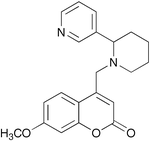A fluorescent “off–on–off” proton switch derived from natural products and further studies of first-generation fluorescent photoinduced electron transfer (PET) systems
Abstract
Two new second generation fluorescent switches that are based on the chromophore–spacer–receptor architecture are reported in this paper. The fluorescence modulation of these switches is a result of quenching or initiating photoinduced

- This article is part of the themed collection: Fluorescent sensors

 Please wait while we load your content...
Please wait while we load your content...